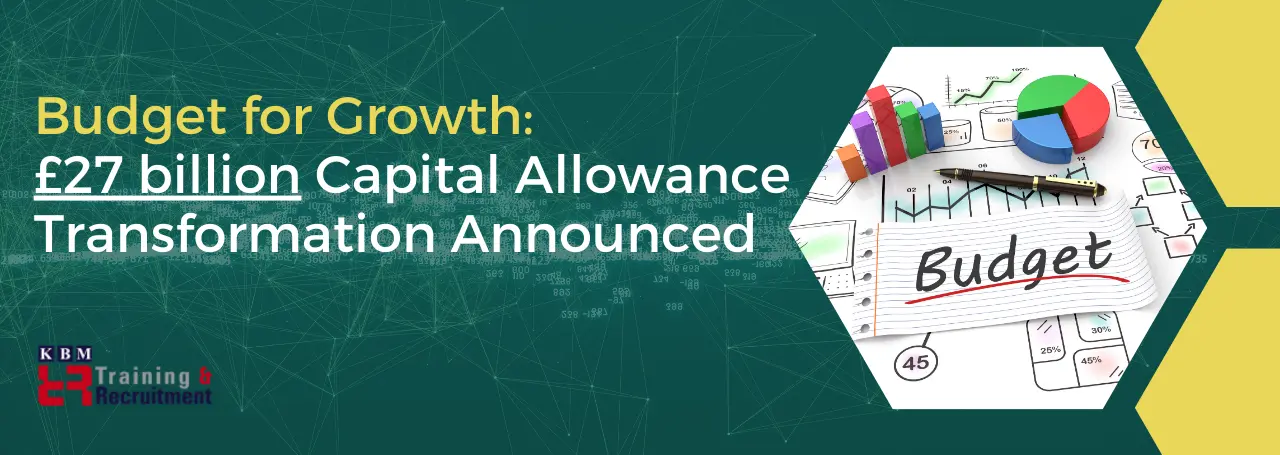Chancellor Hunt's Budget for Growth announced a £27 billion transformation in the form of capital allowances from April 2023 for three years. This tax relief allows businesses to save up to 35% on their overall tax bill while investing in energy-efficient assets that qualify for additional tax credits. The Budget for Growth offers businesses a unique chance to use tax breaks to support their growth strategies and gain access to generous incentives.
This article will present the details of this transformative budget, the benefits it offers businesses, and how you can use this budget to support your growth strategy.
Overview of Chancellor Hunt's Budget for Growth
Rishi Sunak, as the Chancellor of the Exchequer, presented the Budget for Growth in March 2021. The budget includes a £27 billion capital allowance transformation, allowing businesses to save up to 35% on their overall tax bill. This transformation enables businesses to claim tax relief on investments in plant and machinery and take advantage of other tax breaks. Also, the budget offers generous tax credits for energy-efficient assets. Businesses can use these investments to support their growth strategies and gain access to more incentives than ever before.
The purpose of the budget is twofold: to help business owners save money on taxes and invest in low-carbon technology that will benefit the environment and create jobs. The budget also aims to drive investment into areas central to economic growth, such as infrastructure, innovation, and skills training.
Businesses can use the allowance provided by the Budget for Growth in multiple ways: purchase new equipment or machinery, restructure existing investments, make improvements that enhance productivity, or reduce energy costs. Additionally, businesses can use these allowances to claim capital gains tax relief when selling certain assets or investing in research and development projects which may qualify for additional tax credits.
Finally, Chancellor Hunt's Budget for Growth provides a unique opportunity for businesses looking to invest in low-carbon technology and save money on taxes simultaneously. With generous incentives within this budget package, companies can take advantage of these beneficial opportunities and invest in resources that will help them grow faster.
Coverage of the £27 billion Capital Allowance Transformation
The £27 billion capital allowance transformation offers businesses a range of tax breaks and allowances, allowing companies to save up to 35% on their overall tax bill. Here is a breakdown of the main elements included in this transformation:
1. Annual Investment Allowance (AIA)
You can use AIA for new business purchases or replacements for existing assets. It allows businesses to claim up to £1 million per year on investments in plant and machinery. It's important to note that this allowance does not cover intangible assets such as software or intellectual property.
2. First-year Allowance (FYA)
FYA, businesses can claim 100% of the cost of qualifying assets with a short life of two years or less. It is a handy tool for businesses that need to invest in technology quickly, such as IT systems or machinery, to keep up with industry trends and remain competitive.
3. Structures and Buildings Allowance (SBA)
SBA allows businesses to claim back 12% of the cost associated with building structures and buildings over various periods depending on when construction began. You can claim this relief for any type of building, including warehouses, offices, retail premises and agricultural buildings.
4. Research & Development Expenditure Credit (RDEC)
RDEC offers businesses a generous tax credit for Research & Development expenditure - up to 12%. Qualifying expenditure includes salaries, subcontractor costs, materials, and software used solely for R&D. This relief applies if you're developing products outside the UK but using UK staff or equipment. There was a £500 million for R&D. Also, Mr Hunt announced funding for skills and support for 12 investment zones across the UK.
By taking benefit of these allowances and credits available through Chancellor Hunt's Budget for Growth, businesses can save money while investing in low-carbon technologies that benefit their bottom line and the environment by reducing emissions from energy use across their operations.
Benefits to Businesses Who Take Advantage of the Tax Breaks
The generous tax breaks announced in Chancellor Hunt's Budget for Growth offer numerous benefits to businesses that take advantage of them. Companies can use the allowance to save up to 35% on their overall tax bill, allowing them to invest more into capital assets and depreciate them more quickly. This makes it easier for businesses to acquire the assets they need to grow their operations and stay competitive.
The budget also offers businesses access to more generous loan limits and other financial assistance measures, allowing business owners to support their growth strategies further. With these resources, companies can purchase or lease equipment, hire additional staff, or invest in research and development projects without worrying about overspending. Additionally, businesses can write off more of their annual investment costs if they qualify for certain tax credits, such as those offered for investing in energy-efficient assets.
Businesses that make use of the capital allowance transformation will be able to benefit from increased cash flow due to reduced taxes paid. The extra funding allows business owners greater flexibility when investing in energy-efficient technology and other initiatives to help reduce emissions from energy use while staying profitable.
Furthermore, depending on their particular sector, businesses may be eligible for additional grants or incentives. This could provide even more significant savings on taxes paid and allow them to reinvest in new technologies or expand operations further.
Businesses that take advantage of the Budget for Growth's generous tax breaks have potential access to reduced not only taxes but also increased funds available for investments in low-carbon technology that will benefit both the environment and create jobs. Investing in these tax breaks has potential long-term benefits by providing a company with financial stability while staying compliant with regulations regarding emissions reduction targets.
How to Use the Budget for Growth to Support Your Business's Growth Strategy?
Businesses can use the Budget for Growth to support their growth strategies and take advantage of the generous tax breaks available. Companies can get most of this by identifying which tax breaks are relevant, planning accordingly, and tracking the costs associated with taking advantage of those tax breaks.
The first step is identifying which tax breaks are relevant to your business. Depending on your industry and size, different tax breaks may be more beneficial than others. For example, if you own a manufacturing business, you can use the Annual Investment Allowance or Structures and Buildings Allowance to invest in new plants and machinery or develop premises without incurring additional taxes.
Additionally, businesses should research any potential risks associated with taking advantage of the tax breaks before making a final decision. Once you have identified the relevant tax benefits for your business, creating a financial strategy that considers how long it may take to benefit from these tax breaks is essential. It includes tracking all costs of implementing these changes, such as any legal or professional fees incurred.
Doing so will ensure your business doesn't overextend itself financially to take advantage of the budget's opportunities. Also, companies must research any potential risks associated with taking advantage of these tax reliefs before deciding whether they would like to proceed.
Some areas where companies could encounter risks include compliance issues or failing to meet specific eligibility criteria set by HMRC, which carry financial penalties if breached. When evaluating their options, businesses should also consider any other implications, such as changes in cash flow due to reduced taxes or access restrictions due to loan limits.
Ultimately, businesses should seek professional advice on how best to use Chancellor Hunt's Budget for Growth to support their growth strategies before implementing them. This advice should include an evaluation of what short-term and long-term impact these changes will have on the company's finances and overall success, as well as how they could affect other stakeholders such as employees or customers who may have impacts of these changes too.
Conclusion
The Capital Allowance Transformation is part of the Government's commitment to supporting businesses, investing in their growth and enabling them to create opportunities for everyone in society. The Transformation affects the UK's tax system and reduces the taxes businesses, and corporations pay by approximately £27 billion from April 2023 for three years. It will include 'full expensing' of investment on IT, plant, and machinery for three years, plus an extension to the 50% first-year allowance in the same period. Also, Mr Hunt's announcement includes funding for skills and support for 12 investment zones countrywide.






















